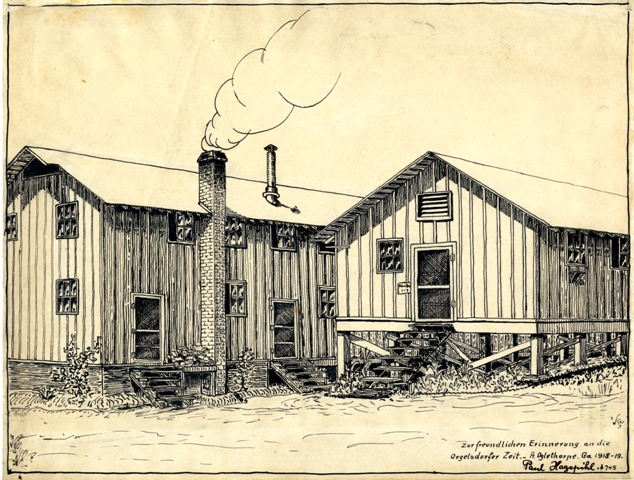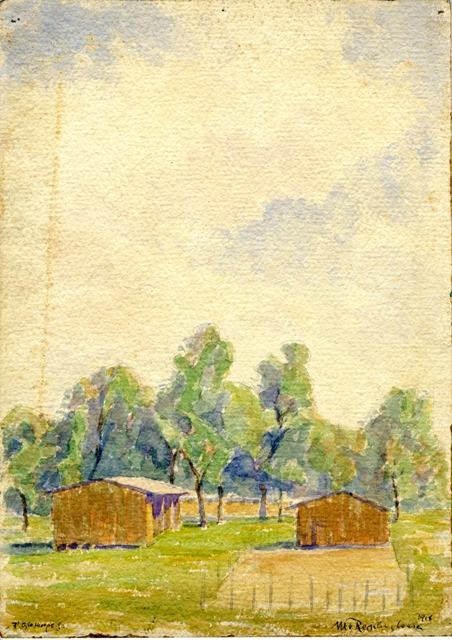
Federico Stallforth, Bunk, Fort Oglethorpe, GA, watercolor, 1918-1920.  Stallforth Family Papers, © Mary Prevo, 2009.

- Federico Stallforth, View of Fort Oglethorpe, GA, watercolor, 1918-1920, Stallforth Family Papers, © Mary Prevo, 2009.
Papsi was interned at Fort Oglethorpe, GA, as an enemy alien during WWI.  He wasn’t released until after the Treaty of Versailles was signed, which means he was incarcerated until 1920.  The year before his arrest, he was held briefly for questioning on Ellis Island.  It is clear that he operated as a money man for a ring of German saboteurs who were operating in North America in the years prior April 1917.  These men were charged with disrupting American munitions manufacturing, raw material production (mining), and shipping.  They financed these activities by selling German War bonds on the American Stock Exchange.  Papsi was one of their more successful brokers.  It appears that everything Stallforth and Company did up until 1916-ish was legal according to the letter of the law.  When the actual saboteurs and their handlers were rolled up by the British and the Americans in 1916, Papsi and his immediate collaborators took over the roll of paymasters for those who remained.  It was principally for these actions in the months leading up to the US entering the war in April 1917, that Papsi was interned.  It is a fascinating story that includes Pancho Villa and military activity on the US/Mexican border.  There is a historian, Heribert von Feilizsch, who is researching this story for a book.  Papsi is just part of it.  I have given Harry access to the Stallforth family letters and photographs and am optimistic that his work will result in an important book.
I am more interested in the effect all this had on his children, our Gumma and Dita. Â Their mother, Anita, died on January 25, 1917 of stomach cancer. Â Papsi was arrested and held for a short time on Ellis Island in April, 1917, just after the US declared war on Germany. Â Adi, their mother’s sister, was running the house and taking care of them with the help of Siddy (sp?), who was the loyal family chauffeur. Â Sidddy taught Gumma to drive. “Never run over anything in the road, especially a piece of wood, because it might have a nail in it, Siddy always said.”
I just found out from documents that Harry shared with me this weekend, that Adi had a major operation and was in the hospital for two weeks during Papsi’s incarceration. Â Papsi wrote several times to the authorities (F.B.I. chief) to grant him temporary parole to go home and take care of his children while his sister-in-law recovered. Â Others wrote in support of his request. Â In these letters, it is made clear that the children are alone and it is difficult to get help for them because the neighbors are afraid that this would constitute “giving aid and comfort to the enemy.” Â NO wonder Dita was a cautious and fearful child! Â And no wonder Adi, Gumma, and Dita have such strong attachments to the Stoehr and Jellinghaus families. Â Remember Tidily and Heine Beisner and how loyal Dita and Gumma were to them as they aged? Â Tidily was a Jellinghaus. Â The Jellinghaus family was in NYC and befriended the girls. Â I don’t know how they met. Â It may have been through the school Dita attended.
The watercolors here were done by Papsi while he was in Fort Oglethorpe.
All images copyright, Mary Prevo





